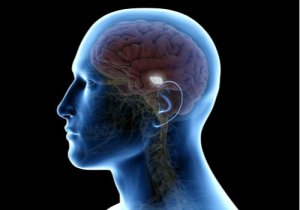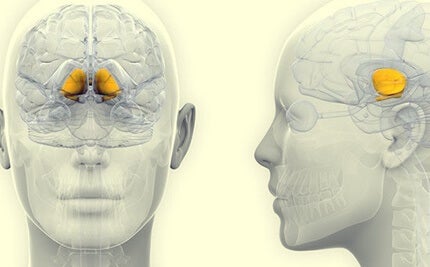Dark Matter - Moving and Learning

Dark matter is one of human’s most amazing brain structures. Although you might think it’s unimportant if you judge it by its size, it’s vital for your body.
This article is about dark matter. Here, we’ll define it and discuss its parts and functions. In addition, you’ll learn what diseases may result from any related alteration. Are you ready to learn more?
What exactly is dark matter?
This structure is part of the basal ganglia, a circuit of interconnected nuclei. It resides in the midbrain of your brain. In addition, you have it on both sides of your brain, that is, there’s one in each cerebral hemisphere.
You’re probably wondering why it has this name. Well, it turns out that the neurons of this structure have a pigment that gives them a dark tone. The name of this pigment is neuromelanin and is present in dopaminergic neurons, which are abundant in this area.

Functions of dark matter
Dark matter has two parts and each of them has a separate function:
- Compact. This one is responsible for the transmission of signals to the rest of the basal ganglia. In addition, it initiates and regulates fine motor skills through projections of dopaminergic neurons. The main characteristic of this area is that it’s darker so it contains more dopaminergic neurons.
- Cross-linked. Its function is to send signals from the basal ganglia to different areas of the brain, especially to the thalamus, and the information control center. It contains fewer dopamine neurons.
On this note, don’t you believe for a minute that the cross-linked section doesn’t have an essential role because there are more dopaminergic neurons in its compact part. It particularly helps neuronal inhibition through the GABA neurotransmitter.
Learning
Dark matter is tied to the learning processes, as it mediates the brain’s response to stimuli. Its function is to facilitate learning, thanks to the reinforcing effects of dopamine. In addition, it’s mainly involved in spatial learning.
Ok, but why this function? This is because a large number of dopaminergic neurons activate when surprising stimuli appear. This would support the implication of this structure, as it contains neurons of this type. However, it doesn’t do it in isolation. Instead, it acts in conjunction with other brain structures.
Motor skills
As we mentioned at the beginning of this article, dark matter is part of the basal ganglia, a set of nuclei that influence movement. So what’s the specific action of this black substance? Start and direct the movements in which fine motor skills are necessary.
Eye movements influence the activation of the reticulated part in association with the thalamus and other nervous system structures. They work above all so that our gaze stabilizes, in the movements of our face and our head. In addition, they intervene in visual processing.
Reinforcements and rewards
When you have pleasant sensations, the neurons of dark matter also activate and participate in the reward circuits. In fact, according to Bear, Connors, and Paradiso, authors of the book Neuroscience: Exploring the Brain, it facilitates the prediction of behaviors that involve reinforcement.
Thus, when behavior patterns repeat, the dark matter acts as well. This is because there are associations between stimuli and reactions. Therefore, this matter is linked to motivation, reinforcements, and addictions. Mainly because the adaptive use of learning can trigger it.
Sleep regulation
Again, the dopaminergic neurons found among other places are very important in this structure. They regulate your biological rhythm of sleep; that is, it has to do with wakefulness sleep patterns. This is the type of sleep that’s most active, rapid eye movements. Isn’t it incredible?
In addition to these functions, dark matter plays a role in temporary processing. That is, in the perception of time in terms of the detection of stimulus intervals.

Diseases associated with dark matter
As you’ve seen, dark matter acts in various potential functions. Therefore, alterations can lead to various diseases. Here are two of the most serious:
- Schizophrenia. This is a mental disorder in which dark matter seems to be involved. What happens here is that this disorder alters the dopaminergic pathways, including the levels of this neurotransmitter. In fact, they can go pretty high in this disease. Thus, it isn’t uncommon for the disease to have symptoms that pertain to motivation and mood.
- Parkinson’s disease. Dopaminergic neurons degenerate, especially in the compact part of the black matter. In addition, if you reflect a little on its functions, you can see how they’re closely related to some symptoms of the disease: motor disorders, mood, and sleep, for example.
In short, dark matter is what helps you with movement, motivation, sleep, the detection of stimulus intervals, mood, learning, and the connection of nerve signals. Therefore, its absence or alteration leads to significant problems in the processes in which it plays a role.
Dark matter is one of human’s most amazing brain structures. Although you might think it’s unimportant if you judge it by its size, it’s vital for your body.
This article is about dark matter. Here, we’ll define it and discuss its parts and functions. In addition, you’ll learn what diseases may result from any related alteration. Are you ready to learn more?
What exactly is dark matter?
This structure is part of the basal ganglia, a circuit of interconnected nuclei. It resides in the midbrain of your brain. In addition, you have it on both sides of your brain, that is, there’s one in each cerebral hemisphere.
You’re probably wondering why it has this name. Well, it turns out that the neurons of this structure have a pigment that gives them a dark tone. The name of this pigment is neuromelanin and is present in dopaminergic neurons, which are abundant in this area.

Functions of dark matter
Dark matter has two parts and each of them has a separate function:
- Compact. This one is responsible for the transmission of signals to the rest of the basal ganglia. In addition, it initiates and regulates fine motor skills through projections of dopaminergic neurons. The main characteristic of this area is that it’s darker so it contains more dopaminergic neurons.
- Cross-linked. Its function is to send signals from the basal ganglia to different areas of the brain, especially to the thalamus, and the information control center. It contains fewer dopamine neurons.
On this note, don’t you believe for a minute that the cross-linked section doesn’t have an essential role because there are more dopaminergic neurons in its compact part. It particularly helps neuronal inhibition through the GABA neurotransmitter.
Learning
Dark matter is tied to the learning processes, as it mediates the brain’s response to stimuli. Its function is to facilitate learning, thanks to the reinforcing effects of dopamine. In addition, it’s mainly involved in spatial learning.
Ok, but why this function? This is because a large number of dopaminergic neurons activate when surprising stimuli appear. This would support the implication of this structure, as it contains neurons of this type. However, it doesn’t do it in isolation. Instead, it acts in conjunction with other brain structures.
Motor skills
As we mentioned at the beginning of this article, dark matter is part of the basal ganglia, a set of nuclei that influence movement. So what’s the specific action of this black substance? Start and direct the movements in which fine motor skills are necessary.
Eye movements influence the activation of the reticulated part in association with the thalamus and other nervous system structures. They work above all so that our gaze stabilizes, in the movements of our face and our head. In addition, they intervene in visual processing.
Reinforcements and rewards
When you have pleasant sensations, the neurons of dark matter also activate and participate in the reward circuits. In fact, according to Bear, Connors, and Paradiso, authors of the book Neuroscience: Exploring the Brain, it facilitates the prediction of behaviors that involve reinforcement.
Thus, when behavior patterns repeat, the dark matter acts as well. This is because there are associations between stimuli and reactions. Therefore, this matter is linked to motivation, reinforcements, and addictions. Mainly because the adaptive use of learning can trigger it.
Sleep regulation
Again, the dopaminergic neurons found among other places are very important in this structure. They regulate your biological rhythm of sleep; that is, it has to do with wakefulness sleep patterns. This is the type of sleep that’s most active, rapid eye movements. Isn’t it incredible?
In addition to these functions, dark matter plays a role in temporary processing. That is, in the perception of time in terms of the detection of stimulus intervals.

Diseases associated with dark matter
As you’ve seen, dark matter acts in various potential functions. Therefore, alterations can lead to various diseases. Here are two of the most serious:
- Schizophrenia. This is a mental disorder in which dark matter seems to be involved. What happens here is that this disorder alters the dopaminergic pathways, including the levels of this neurotransmitter. In fact, they can go pretty high in this disease. Thus, it isn’t uncommon for the disease to have symptoms that pertain to motivation and mood.
- Parkinson’s disease. Dopaminergic neurons degenerate, especially in the compact part of the black matter. In addition, if you reflect a little on its functions, you can see how they’re closely related to some symptoms of the disease: motor disorders, mood, and sleep, for example.
In short, dark matter is what helps you with movement, motivation, sleep, the detection of stimulus intervals, mood, learning, and the connection of nerve signals. Therefore, its absence or alteration leads to significant problems in the processes in which it plays a role.
All cited sources were thoroughly reviewed by our team to ensure their quality, reliability, currency, and validity. The bibliography of this article was considered reliable and of academic or scientific accuracy.
Bear, M. F. Connors, B. W., PAradiso, M.A. Nuin, X.U., Guillén, X.V & Sol Jaquotor, M.J. (2008). Neurociencias la exploración del cerebro. Wolters Kluwer/Lippicott Williams & Wikins.
Kandel, E. R., Schwartz, J. H., & Jessel, T.M. (2001). Principios de neurociencia. Madrid: McGrawHill Interamericana
This text is provided for informational purposes only and does not replace consultation with a professional. If in doubt, consult your specialist.







